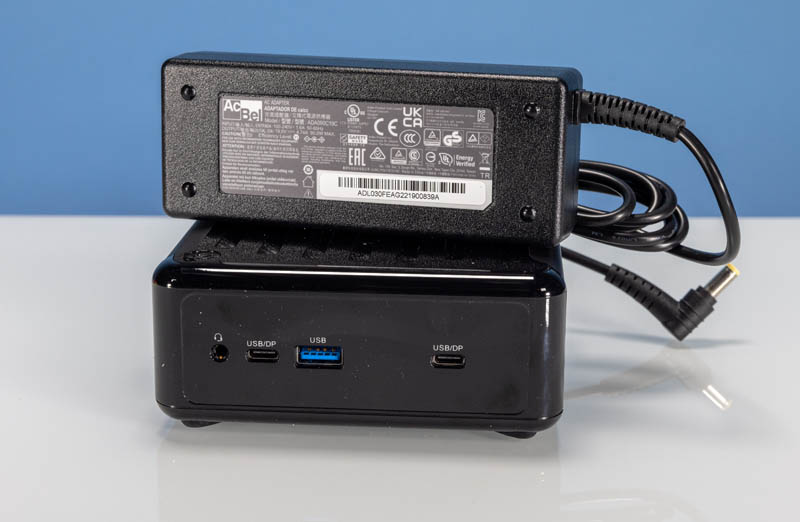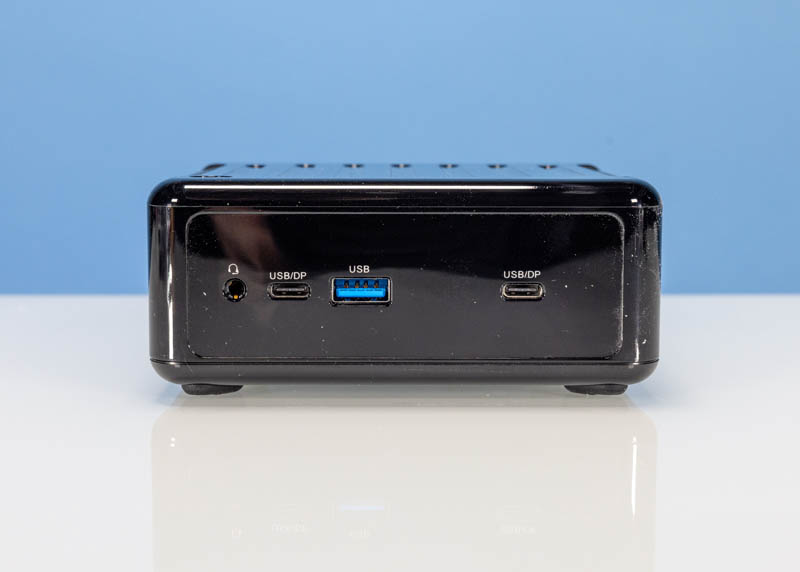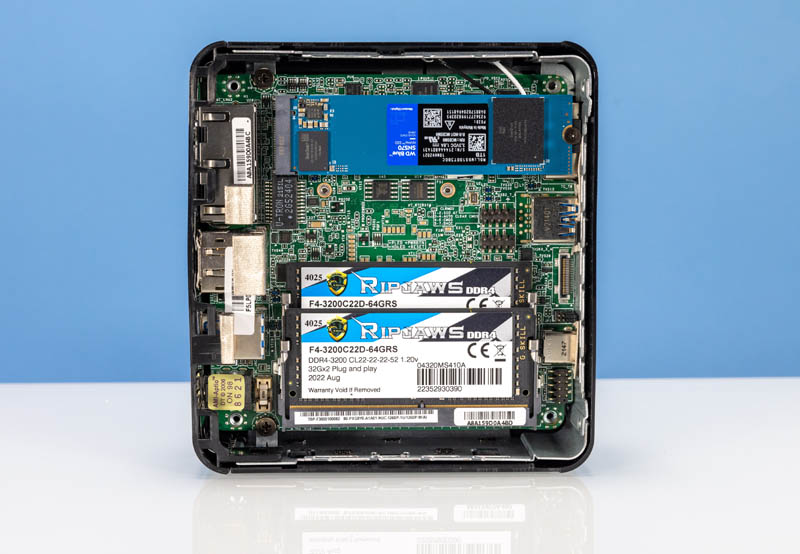ASRock NUC BOX-1260P Power Consumption and Noise
This unit came with an AcBel power brick, and power consumption was relatively good in our configurations. On 120V power, we were in the 15-55W operating range for the system, which is significantly lower than modern Project TinyMiniMicro systems.

A few words on this. We are using default settings that came in our system since that is how we believe most users will use the systems. There is room to increase (or decrease) the CPU performance by adding TDP (or lowering it.) One can use high-performance NVMe SSDs, 2.5″ drives, and so forth as well. So there is a lot of variability in how these get set up and used. Most of our testing was done with the unit using under 30W. Power is important, and this unit was relatively good on that front.
This power consumption was quite a bit higher than the AMD version, with idle consumption of around 15W. In comparison the AMD system’s idle was closer to 10W. During the Geekbench 5 run, the power peaked at about 55W as shown in the video.
On the noise side, this unit during our testing was not loud, especially if it was stuck behind a monitor. You can hear a Geekbench 5 run in the accompanying video recorded at 6″ away from a $1000 Sennheiser MKH-416 microphone (affiliate link) pointed directly at it.
Key Lessons Learned
This unit was really interesting because it was so small, and has a lot of connectivity for its size. The 1L PCs as well as ones like the Minisforum HX90 are much larger. These are the types of systems you can stick in a backpack because they are so portable.

The Intel system is more power-hungry, louder, and costs slightly more than the AMD system but provides a similar level of performance. Based off the CPU performance alone, the AMD unit is probably what most users would assume is better.
On the other hand, Intel has a better platform in this generation. The Intel unit has better connectivity with the dual 2.5GbE NICs (versus one) and the AX211 WiFi. It also has the two USB 3.2 gen 2 ports on the rear of the unit. Inside, we also get a PCIe Gen4 NVMe slot for faster storage. Finally, Intel has a more modern video encode/ decode unit in its iGPU than AMD in these generations.
While the CPU performance is close, and AMD may have an edge on performance per watt in some cases, Intel is providing a more robust platform that many will gravitate to. These units may look the same, the processors may offer similar levels of performance, but the platforms are more different than one would assume at first glance.
Final Words
Many users may see this system and immediately react that they can build a comparable mITX system for less. However, this is not the main benefit of the system being discussed. Building this ASRock Industrial system involves just inserting an M.2 SSD and two DIMMs, and then installing an OS. This system is an excellent choice for Windows or Linux desktop computers that are not primarily used for gaming, as it is much smaller than a mITX system and can be assembled in less than two minutes. Additionally, it is relatively quiet and compact, which are important features of NUC-like systems.

Although this Intel unit may lag behind the AMD unit in some performance areas, this ASRock NUC is still a solid offering for those looking for the form factor and features that this represents.

These units do come at quite a cost, at ~$600 for a barebones unit, and that cost may turn away some users. However, this 12th gen Intel NUC offering is a great blend of compactness and features in a reasonably low-power package. That is really the market that ASRock Industrial is going for with systems like this.




Thermal throttling when running CPU at 90+% performance sustained a few minutes?
Why the AMD version 4X4 BOX-5600U has only one 2,5 GbE ?
I think it’s worth mentioning that one of the Type-C ports supports USB4 (and maybe also Thunderbolt), I have the i5 model and am using a 10GbE Thunderbolt NIC with it.
If it lacks TB then is it NOT a competitor to the Intel NUC
I might be talking about a different device actually, I have an Asrock Industrial NUC BOX-1240P, the main difference being the different CPU and the “industrial” branding – however it looks exactly identical to the reviewed model.
The datasheet says it supports USB4 on the Type C port pending certification, so not really official. I tested with two Thunderbolt devices, one of them a “Sonnet Solo 10G Thunderbolt 3 SFP+” as well as an external NVMe enclosure (also TB3), it works but only on one of the Type-C ports.
Nils
I have over 100 of the Sonnet TB3 to SFP+ on my Intel NUC11 Pros and NUC13 Pros – they have been flawless and faster / more stable than the Intel and Mellanox 10GbE…
So for now we need 1L pc with 5700U, 4 mem slots, 4 x i226 and pcie x 16 slot :)
Does the NUC BOX-1260P support Intel vPro ?
It’s said on intel ark that the i7-1260p should support vPro Essential and the nics are i225-LM, but does the Bios allow it ?
Thanks for the feedback